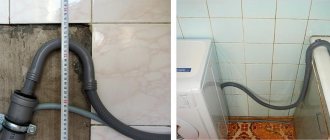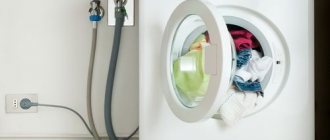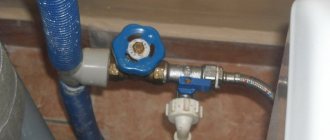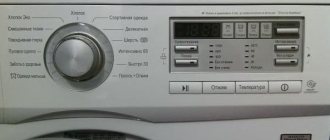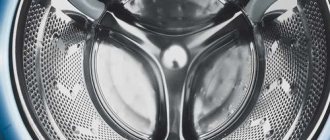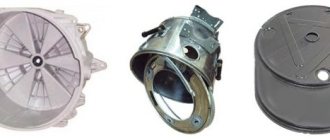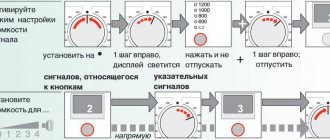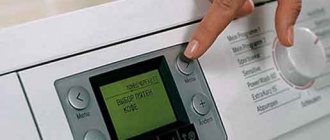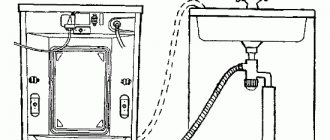The bathroom of a modern city apartment has a huge functional load. It is not only a place where all kinds of sanitary and hygienic procedures are performed; as a rule, this small room is also used for washing.
Our contemporaries practically no longer do laundry manually; this task is entrusted to an indispensable household appliance - an automatic washing machine. The technical ability to connect a washing machine is inside each bathroom. In this article we will discuss whether you need a siphon with a drain for a washing machine, how it differs from a regular one, and how it works.
Siphons: main purpose
Siphons are needed not only to protect premises from unpleasant odors.
Such devices have much more functions:
- Simplifying the operation of the water pump. After all, a hose that is quite long is used.
- Cleaning as necessary will not cause difficulties, because access to the insides is easy and simple.
- The hydrosizer is the main part that prevents the appearance of unpleasant odors and additional noise.
- Protection against various harmful microorganisms.
If there is no siphon, then car owners have additional problems.
If you hang the drain hose at a certain height in a curved form, you can partially cope with the troubles. But in this case, you cannot do without additional extension. And the height will need to be sufficient, at least 500 millimeters above the floor. Such solutions do not always look attractive in existing interiors.
Purpose
Many people believe that the main purpose of the siphon, which is used to connect a washing machine, is to drain water. But this device is also intended for other purposes:
- The siphon ensures proper operation of the sewer system using a water barrier. This allows you to forget about unpleasant odors in the room where the machine is installed. Many consumers don't pay attention to this feature until sewer odors enter their home. Replacing the siphon will help solve the problem.
- The device collects all small debris and parts that enter the system during washing and prevents them from entering the sewer pipes. The siphon allows you to prevent clogging of the sewer system, since regular cleaning of pipes is quite problematic. Sometimes it is simply impossible to use chemicals to clean pipes, since the material of the pipes itself can be damaged. Some models of washing machines have a separate compartment that collects all the dust, wool and small objects. But if the model does not have this storage device, then the main load goes entirely to the siphon.
- To facilitate the operation of the washing machine pump , bends in the drain hose are used.
Description of the device and operating principle
Siphons are considered useful accessories that help reduce the load on pumps. In addition, they eliminate many of the hassles associated with system maintenance.
Structurally, the device is designed to form a so-called water seal. That's why experts say that this is a really necessary detail.
At its core, a siphon looks like a pipe with a curved channel. A certain amount of liquid is used inside, due to which the escape of gases after draining is completely prevented. The water plug prevents excess particles from getting inside the main parts of the system.
It is now difficult to imagine connecting washing machines to a drainage system without the use of siphons. These same devices make it possible to connect other equipment such as sinks, showers, and so on.
The devices are made of plastic, because it is protected from rust even when exposed to moisture. Brass and copper are also used, but less frequently.
Kinds
The presence of a siphon ensures good drainage of water, extends the life of the washing machine and helps to avoid possible problems that arise from sewer blockages.
Choosing a suitable siphon is quite simple, since there are only two types of this device on the plumbing equipment market.
Related article: Wallpaper design for the living room: what to choose for the interior
Combined
Use in any room. It allows water to be drained from the sink, and an additional pipe ensures a reliable connection of the automatic machine to the sewer system.
Separate (external and built-in)
- A separate siphon is often used to connect an automatic washing machine. It can be external or built-in.
- The external siphon is characterized by small dimensions, but requires more space than the built-in element, which makes it difficult to install the machine near the wall. It is attached to the sewer pipe using an O-ring.
- a built-in siphon “boxed”; it requires less space than an external one. It is completely hidden in the wall, only an invisible pipe remains. Using the built-in siphon, you can install the washing machine tightly to the wall. Installation of this device is very simple, but you only need to prepare a special recess in the wall in advance. This variety is in great demand among buyers, because it carries out a hidden automatic discharge of water from the machine. First, the walls are tiled, and then the siphon is installed in the recess.
Getting ready for further use
Before starting to work with the product, it is recommended to carefully inspect all components. This will allow you to identify existing defects and defects in advance. The main thing is to take a closer look at the threaded connections.
After this, you can choose the place where the equipment will be installed. We also need to decide on the method of laying communications. It is necessary to take into account the features of a particular siphon model so that the work is done correctly. All that remains is to choose the appropriate tools and additional materials.
What rules are followed when connecting?
Some manufacturers have low efficiency pumps.
Other recommendations can be made:
- It is not recommended to lengthen the hoses during installation.
- Pulling a hose onto the outlet pipe is a standard scheme that can be used to connect equipment to a siphon.
- A union nut is another acceptable option.
The work with the structure itself is not difficult, but following simple rules will avoid negative consequences. The drain can only be connected if the siphon itself is located at a height of up to 800 millimeters above the installation site. It is also possible to use larger parameters.
But in this case, operating the pump is often difficult. And the device fails ahead of time. If the hose length is not enough, then manufacturers recommend abandoning the idea of extension. It is better to lay additional sewer pipes with sufficient diameter. Then there will be less difficulties in your work.
If only an extension is available, the hose must be secured in such a way that a certain slope towards the sewer pipes is maintained. The manufacturer's instructions should describe in as much detail as possible what actions are performed and how they are performed. In normal situations, the open end of the drain pipe should be located at least 60 centimeters above the floor level.
The nuances of connecting a washing machine to the drain
Before purchasing a certain machine model, you must first read the instructions in the instructions to determine what water pressure should be to operate the product.
If the apartment is located on the upper floors, then it is necessary to check that the height difference and the storage tank can create the required pressure. On the lower floors this problem is completely absent.
Sometimes difficulties arise when connecting an automatic machine to a drain due to its location.
There are several connection methods:
- directly to the bath;
- to the siphon, which is located under the sink or sink;
- to the sewer pipe.
To connect the machine directly to the bathtub, only a hose is used, as well as a holder on the side of the bathtub. These devices are sold complete with equipment.
To connect a siphon for draining an automatic machine to a sink, you need to purchase a model with a special pipe. To connect to the pipe, a hose from the machine is connected and secured with seals.
The last mounting option, which is made to a sewer pipe, is more complex, but is also often used.
When connecting the machine to the siphon, you should pay attention to two nuances:
- The drain must be connected at a height of about 60 cm to reduce the load on the functioning of the pump.
- It is not recommended to extend the drain hose so as not to create additional stress on the pumping system. If the length is not enough, then this problem can be solved by using an additional sewer tube, the diameter of which will be only 3.2 cm. First, the pump will push water through the hose, and then it will flow randomly through the additional tube. If you decide to extend the hose, be sure to secure it at the required height, rather than throwing it on the floor, and make the right angle for good water drainage.
Installation: some features
If the room is small enough, then owners often have to place the machines downstairs under the sink. In this case, the dimensions of the latter must exceed the dimensions of the device. Then moisture will not get on the equipment.
Siphons are usually chosen with a vertical arrangement. This allows you to ensure that the equipment is as close to the wall as possible. Manufacturers supply such products assembled.
All that remains is to install it in the socket of the outlet network, where the sealing ring is also installed. Do-it-yourself installation allows you to save additional money. The main disadvantage is the need to place the siphon closer to the sink.
How is installation done?
Automatic washing machines are expensive types of equipment. Therefore, you must strictly follow the manufacturer's instructions when installing. The higher the cost of the product, the more expensive the repair will be later.
Installing siphons with outlet
Siphons have an appearance much like regular sinks. The only difference lies in the absence of a separate pipe to which the machine is connected. The installation also has a standard scheme, which is used in almost all bathrooms. Sometimes they only change the tube with the fitting, and not the siphon itself, but such options cannot be considered acceptable.
The description of the process will be as follows:
- We remove the old device completely. For this purpose, two plastic nuts are unscrewed, which are responsible for fastening to the drain and other parts. The main thing is not to forget to place a container where dirty water flows.
- The drainage of the sink into the sewer is thoroughly cleaned. Dirt and deposits must be completely removed.
- We install a new siphon. The main thing is to remember to screw the plastic nuts tightly when the work is almost finished.
- We put the hose from the machine on the fitting, which is intended for this.
- The connection is tightened to ensure maximum tightness.
About installing built-in products
The main thing is to think in advance about how the washing machine connects to the sewer. Special siphons for water drainage are built in if the equipment has its own permanent place. The installed product is completely covered using moisture-resistant plasterboard. There should be a tile on top. Only a small outlet should be left outside, through which the hose is connected.
Putting on the nut or tightening it are simple but effective ways to complete the fastening. These types of siphons have the main advantage of maintaining a small distance between the machines and the walls. The connections themselves have an attractive appearance.
Thanks to siphons, pumps are protected from additional loads. Provides complete protection from harmful effects from the sewerage system.
Criterias of choice
Today, the manufacturer offers many options for siphons of various sizes and shapes, which require a variety of installation methods, and also have a different number of holes for water drainage.
It is very important to choose the right siphon, especially if you plan to use it to connect not one, but several plumbing elements at once, for example, a sink and a washing machine at the same time.
There is a division of siphons by type, for example, a siphon with an outlet for a washing machine, a special siphon splitter, a siphon that is built into the wall, and also one that has a check valve.
Metal siphon for washing machine
Each owner determines for himself which siphon he needs. For example, during repairs, you can bother searching for built-in models. For residents of the first floors, a device with a check valve is ideal, which will prevent wastewater from entering the washing machine if the pipe is clogged.
Mostly plastic siphons are presented on the market. But if you wish, you can also look for a metal one, but it is worth considering that with a metal siphon there will be more difficulties during operation and maintenance.
In addition to all of the above, when choosing a siphon you should pay attention to the country of manufacture. Since this often directly affects the quality of the product. It is equally important to determine the material for making the siphon and the conditions for its operation in the future. For example, if you plan to use it to connect not only a washing machine, but also a sink, then you will need a siphon with several holes.
When purchasing, you should carefully inspect all the parts of the siphon and make sure that the system is solid without cracks, chips or other defects. It is also advisable to check that the threads at the joints are not worn out anywhere, and that all rubber gaskets match the size of the pipes.
Check valves: what are they for?
Non-return valves are additional devices installed in the same place where the washing machine is connected to the sewer. Purpose – to prevent spontaneous drainage of water. In addition, this part of the design prevents wastewater from entering the system from the sewer system. This is relevant in case of blockages or flooding.
Integrated check valves are becoming a must-have addition for modern high-quality designs. A regular siphon should be sufficient to ensure trouble-free operation. But this element is not always present in designs that are outdated.
In the latter case, a siphon equipped with a check valve is needed.
Check valves are built into the connecting sleeve, which are usually used for fastening. Such devices are available in various varieties. Some models are specially designed for the washing machine drain hose.
Tips and tricks
We have collected tips from master plumbers. We hope you find them useful.
Install in an easily accessible place
The outlet valve of the washing machine, installed on the drain, becomes clogged and breaks over time. And installing it in a place where it is difficult to reach will only complicate your life. In an emergency, you will need to quickly disassemble the valve, clean it or make repairs so that the laundry does not have time to be in dirty water.
Which to choose
List of the most reliable and popular check valves
- Italian exhaust valve Type: mortise. Body material: polypropylene. Installed in a drain pipe or attached to a hose to drain water. The mechanism is based on a spring with a rubber membrane.
- Czech valve from . Wall. The plastic case contains a water seal made of a ball with a spring. Universal: suitable for any hose. The main advantage is the affordable price.
- In third place is another representative of Italy from. The body is made of polypropylene. Installed in a siphon under the sink. The mechanism is spring.
- Mini-siphon from the Russian manufacturer ANI Plast. Mounts anywhere on the pipe. The locking mechanism consists of a spring-loaded polymer ball. The polypropylene body is resistant to aggressive environments and temperature changes.
- Siphon for connecting a washing machine from the Scottish company McALPINE. The beautiful plastic chrome-plated body does not spoil the aesthetics of the interior. Standard water seal with polymer ball and reflector.
Is it really necessary or how can I do it myself?
You can do without additional expenses by making the shutter yourself, using a standard corrugated hose that goes from the machine to the sewer. This is done simply - the hose needs to be organized so that the top point is above the level of the washing machine tank. The laws of physics and gravity will not allow the liquid to flow back into the “washer”.
But this is not a solution to the problem, but only a temporary solution. The fact is that the pump wears out due to the long hose and its bend. The pump has to work hard to move water through such a distance. In addition, cleaning turns into torture, since you have to completely disconnect it from the washing machine.
When connecting a hose to drain water directly to the sewer, use a rubber coupling. It will make the connection more airtight.
With this method, the waste pipe outlet must be raised 50 cm from the floor. Otherwise, the water seal will not work.
The hose may also not be long enough. To extend it you will need a piece of a similar hose and a special coupling. But over time, water begins to leak at the junction.
Connected equipment: testing
The quality of the connections is checked for leaks after the work is completed. Bolts, clamps, nuts and other similar elements should be tightened as tightly as possible.
Gaskets with a rubber base should also be positioned evenly inside the holes. The compaction must be uniform along the entire circumference.
After this, all that remains is to turn on the washing machine and select an operating mode so that a sufficient amount of liquid is collected. Afterwards, the mode is changed so that the water is drained as usual. A layer of paper towels or toilet paper is placed where the joints go.
Installation and some features
A sink or countertop can hold sinks that operate with an overflow. The main thing is to know in advance where and how the machine itself will be located.
- The location is exactly under the sink. Then siphons built into walls or flat ones are suitable. All that remains is to screw them to the drain near the sink. The corrugated hose is inserted into one of the outlets. The other end of this device should already be directed into the sewer pipe. The drain hose of the washing machine is connected to the second outlet; fastening involves the use of a clamp. This completes the installation.
wall-mounted siphon
- Under the countertop, to the left or right of the sink. In such situations, it is allowed to use any siphons equipped with outlets for sinks. But this is only theoretical. You just need to take into account that the space under the sink remains open. This means that an outside visitor will easily notice the complete design of the siphon. Another reason to choose wall-mounted varieties.
- The washing machine is located at a considerable distance from the sink, under a long countertop. This arrangement also implies the possibility of using any siphon. All that remains is to make sure that the appearance of the room does not suffer too much. But there is one additional feature that needs to be taken into account. After all, the washing machine is located quite far from the sink. Therefore, the standard drain hose may not be long enough. You will have to buy an extended device. It is this variety that replaces the standard one.
Assembly and installation of a siphon under the sink above the washing machine
Installation of the product is not particularly difficult. As a rule, the instructions included in the package are sufficient. But there are some points that you should pay attention to in order to achieve the desired result:
- Before starting installation, you should check the presence of all parts and the absence of defects on them. This is especially true for sealing and threaded elements.
- The plastic nuts included in the siphon design are tightened by hand, without the use of any keys. This way there is no risk of damaging them by over-tightening.
- Cone seals made of rubber are installed with the wide side towards the nut that secures the siphon parts.
- When assembling a flat siphon, it is better to use silicone-based sealants: the structure is unlikely to be disassembled often, and additional protection for such expensive equipment as a washing machine will not hurt.
